|
I can’t believe that I’m finally leaving!
Posted 10/20/06
Frank Williams
The diatribe below is NOT a representation of of my future postings. I was asked to post this information by some of my boating friends and a couple of members of the MC30 Owners Group. Most normal people will find this posting less than entertaining and, for this, I apologize. I will try to make up for it in future postings. Thanks for your understanding.
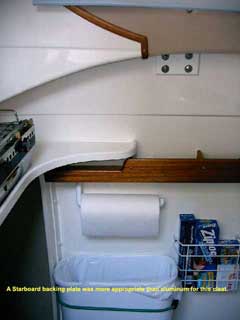 Finally, after 6 months of working on the boat, the time is here to leave on the cruise. As all of my friends know; every few years I buy a new (to me) boat, outfit her for extended cruising and then take off for a winter of cruising and spear fishing in the Bahamas. When I get back, I sell the boat and go back to work. Friends have often asked me why I sell my boats when I get back, why not just keep one of them? After all, I had spent months on upgrading all of the systems; invested hundreds of hours and thousands of dollar to just then turn around and sell them. The answer is that boats don’t do well if they’re not being used on a regular basis. My job has me traveling all over the country with no time at home to use the boat. To be worrying about my boat during winter freezes or hurricane season also takes away from my focus on work. To this end, every few years when I get back from a cruise, someone gets to buy a boat that has been gone over with a fine tooth comb and has been meticulously upgraded with only the finest quality marine components. Finally, after 6 months of working on the boat, the time is here to leave on the cruise. As all of my friends know; every few years I buy a new (to me) boat, outfit her for extended cruising and then take off for a winter of cruising and spear fishing in the Bahamas. When I get back, I sell the boat and go back to work. Friends have often asked me why I sell my boats when I get back, why not just keep one of them? After all, I had spent months on upgrading all of the systems; invested hundreds of hours and thousands of dollar to just then turn around and sell them. The answer is that boats don’t do well if they’re not being used on a regular basis. My job has me traveling all over the country with no time at home to use the boat. To be worrying about my boat during winter freezes or hurricane season also takes away from my focus on work. To this end, every few years when I get back from a cruise, someone gets to buy a boat that has been gone over with a fine tooth comb and has been meticulously upgraded with only the finest quality marine components.
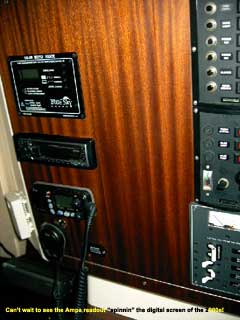 In the past, I’ve taken sailboats, such as; Pacific Seacrafts, Island Packets, a Gemini 105Mc and even a Marine Trader Europa trawler on this cruise. This year I bought a Motorcat 30 for my trip because I was looking for a faster, shallow draft, motor vessel that could be trailered during the hurricane season and would be able to take the best advantage of the winter weather patterns common to the southern Bahamas. A boat that could take advantage of the one day of oily slick, 200 foot visibility (surrounded by lots of days with somewhat choppy water with visibility ranging from 20′ to 100′) and make a day trip diving run from the Exumas to the Jumentos or Conception Island or even Rum Cay. I wanted a boat that would be reasonably economical to operate and have the creature comforts needed for 8 months of living aboard. The only boat that I could find that fit all of my requirements with the least amount of compromise was the Motorcat 30, made by Bond Yachts. So early this spring, I bought the only used Motorcat on the market, a 2002 model, and and started to work on her to bring her up to my specifications for extended cruising and diving in the Bahamas. In the past, I’ve taken sailboats, such as; Pacific Seacrafts, Island Packets, a Gemini 105Mc and even a Marine Trader Europa trawler on this cruise. This year I bought a Motorcat 30 for my trip because I was looking for a faster, shallow draft, motor vessel that could be trailered during the hurricane season and would be able to take the best advantage of the winter weather patterns common to the southern Bahamas. A boat that could take advantage of the one day of oily slick, 200 foot visibility (surrounded by lots of days with somewhat choppy water with visibility ranging from 20′ to 100′) and make a day trip diving run from the Exumas to the Jumentos or Conception Island or even Rum Cay. I wanted a boat that would be reasonably economical to operate and have the creature comforts needed for 8 months of living aboard. The only boat that I could find that fit all of my requirements with the least amount of compromise was the Motorcat 30, made by Bond Yachts. So early this spring, I bought the only used Motorcat on the market, a 2002 model, and and started to work on her to bring her up to my specifications for extended cruising and diving in the Bahamas. 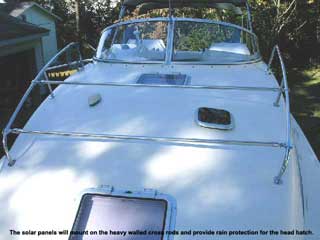
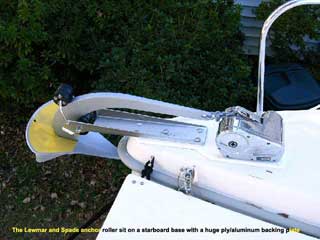 Before I decided what to install on the boat, I went through the boat in great lengths with a flashlight, multimeter and other tools required to remove trim panels etc. and see how she was made. My first impression (one that I still have today) is that the fiberglass work done on this boat is some of the best that I’ve ever seen. I have yet to find a void or unbonded glass/coring. On the other hand, I wasn’t thrilled with the use of stainless washers for backing plates. So my first job was installing aluminum backing plates everywhere. Anywhere there was coring, I drilled out the bolt holes oversized, filled in the holes with thickened epoxy and then redrilled the holes to the proper bolt size through the cured epoxy before bolting back the fitting with it’s new aluminum backing plate. I’ve recently been told, by a marine surveyor, that this is overkill on my part, but it makes me feel better so… In some cases, plywood or starboard were used as backing plates because the material was more appropriate for the particular application. Before I decided what to install on the boat, I went through the boat in great lengths with a flashlight, multimeter and other tools required to remove trim panels etc. and see how she was made. My first impression (one that I still have today) is that the fiberglass work done on this boat is some of the best that I’ve ever seen. I have yet to find a void or unbonded glass/coring. On the other hand, I wasn’t thrilled with the use of stainless washers for backing plates. So my first job was installing aluminum backing plates everywhere. Anywhere there was coring, I drilled out the bolt holes oversized, filled in the holes with thickened epoxy and then redrilled the holes to the proper bolt size through the cured epoxy before bolting back the fitting with it’s new aluminum backing plate. I’ve recently been told, by a marine surveyor, that this is overkill on my part, but it makes me feel better so… In some cases, plywood or starboard were used as backing plates because the material was more appropriate for the particular application. 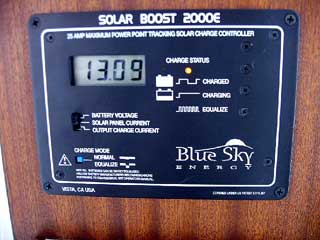
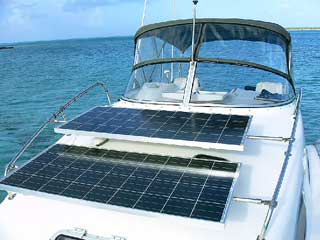 I went through the electrical system and found several problems. The factory did a nice job with the wiring, but subsequent owners or yards had made changes that ranged from inappropriate to dangerous. Dangerous was the 10′ piece of Romex wire used to hook up the microwave which I subsequently removed because it blocked access to much of the limited amount of galley storage. Inappropriate was the 3-way electrical switch that was wired into the system before the factory installed engine on/off switch and the house bank on/off switch in an attempt to have a way to combine the batteries if the starting battery was low. What that did was negate the factory installed on off switches that kept the banks separate. With the way it was set up, you could either run both house and engines off of battery bank one, two or have them combined but you could not run the engines off of the engine battery while at the same time running the house load off of the house bank. I rewired the batteries back to the way the factory had them and then wired in the 3 way switch strictly as an on/off switch to combine the 2 banks. I put in 4 new 6 volt golf cart batteries for the house bank and wired in a Blue Sky Solar Boost 2000e regulator for the two 130 watt solar panels that I’ll get from e-Marine in Ft. Lauderdale. All the wiring has been done, as has the stainless mounting rods so the panels shouldn’t take but a few minutes to mount and hook up. The reason for waiting till Ft. Lauderdale (besides not needing the power as I’m motoring from marina to marina as I head down the coast) is that I’ve dealt with e-Marine in the past and not only are their prices right but they bring the panels preassembled down to the marina and right to my boat. I then clamp them on, hook up 2 wires and my batteries start charging! I’ve also installed a amplified WIFI system that has a 8dBi marine antenna and so far has been able to connect me at almost 8 miles (guesstimate). I’m using this right now anchored near Little River Inlet to upgrade this Web Page. I’ve tried to get a preproduction model of Raymarines Sport Pilot series autopilot, as this is the only model made that will work with a twin cable steered boat. Unfortunately for me, they stopped production of that series at the end of 2005 and won’t have the new and improved Sport Pilot series in production until the first part of 2007. That will make this boat the first one that I’ve ever had to hand steer 100% of the time. I went through the electrical system and found several problems. The factory did a nice job with the wiring, but subsequent owners or yards had made changes that ranged from inappropriate to dangerous. Dangerous was the 10′ piece of Romex wire used to hook up the microwave which I subsequently removed because it blocked access to much of the limited amount of galley storage. Inappropriate was the 3-way electrical switch that was wired into the system before the factory installed engine on/off switch and the house bank on/off switch in an attempt to have a way to combine the batteries if the starting battery was low. What that did was negate the factory installed on off switches that kept the banks separate. With the way it was set up, you could either run both house and engines off of battery bank one, two or have them combined but you could not run the engines off of the engine battery while at the same time running the house load off of the house bank. I rewired the batteries back to the way the factory had them and then wired in the 3 way switch strictly as an on/off switch to combine the 2 banks. I put in 4 new 6 volt golf cart batteries for the house bank and wired in a Blue Sky Solar Boost 2000e regulator for the two 130 watt solar panels that I’ll get from e-Marine in Ft. Lauderdale. All the wiring has been done, as has the stainless mounting rods so the panels shouldn’t take but a few minutes to mount and hook up. The reason for waiting till Ft. Lauderdale (besides not needing the power as I’m motoring from marina to marina as I head down the coast) is that I’ve dealt with e-Marine in the past and not only are their prices right but they bring the panels preassembled down to the marina and right to my boat. I then clamp them on, hook up 2 wires and my batteries start charging! I’ve also installed a amplified WIFI system that has a 8dBi marine antenna and so far has been able to connect me at almost 8 miles (guesstimate). I’m using this right now anchored near Little River Inlet to upgrade this Web Page. I’ve tried to get a preproduction model of Raymarines Sport Pilot series autopilot, as this is the only model made that will work with a twin cable steered boat. Unfortunately for me, they stopped production of that series at the end of 2005 and won’t have the new and improved Sport Pilot series in production until the first part of 2007. That will make this boat the first one that I’ve ever had to hand steer 100% of the time. 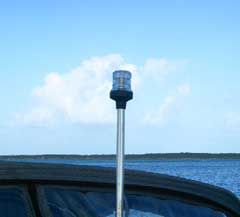
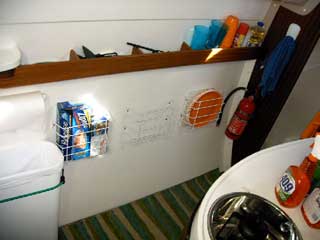 Hope that I’m not boring anyone too badly yet… I installed a hatch in the head to replace the vent, window shades and Oceanair hatch shades. The head was replaced. Wire shelving and baskets were installed to organize the storage without adding significant weight. An Origo 3000 stove was installed, as well as, a Magma Newport (great grill, way better than the old Magna kettles!). A shower was added at the stern platform as well as 2 water tanks, one flexible and one custom made polyethylene, bringing the water capacity to ~75gals. One note on the water tankage – catamarans are very weight sensitive so the tanks were installed centrally to minimize their effect on performance. Also when traveling, I do not plan on carrying a full load of water, that’s only for the 90% of the time when I’m at anchor. I replaced all of the tank fills, as the ones from the factory are made in a way that facilitates water wicking off of the deck and into the tanks if the o-rings are at all compromised. I installed a, new to the market, Lewmar Profish 700 stainless steel freefall windlass. This is a beautiful windlass that makes so much sense. When you reach your destination, this windlass uses a minimum of power to put down the anchor in freefall mode, at a time that you are about to shut down your engines and want to use as little power as possible. The company (Lewmar) is fabulous! I had one minor issue, after installing this windlass, that I think could have been fixed with the application of a lubricant. When I questioned Lewmar about it, they said that “because I was leaving on a trip and was having issues with a new unit,” they would send out a new one immediately and for me to just return the one I had. Two days later, I had the new unit. It took little time to switch the two out, and I did notice that the new unit had the piece in question pre-lubricated. Amazing for a company to go to these lengths to ensure their customers happiness. Bravo Lewmar! And finally, I’ve gone through the 2 Suzuki DF50 4 stroke outboards changing all of the lube, the water pumps, fuel filters and plugs just to get a bit familiar with them. Oh… I almost forgot, I bought a new aluminum Float-On trailer, but that’s a story in itself… Hope that I’m not boring anyone too badly yet… I installed a hatch in the head to replace the vent, window shades and Oceanair hatch shades. The head was replaced. Wire shelving and baskets were installed to organize the storage without adding significant weight. An Origo 3000 stove was installed, as well as, a Magma Newport (great grill, way better than the old Magna kettles!). A shower was added at the stern platform as well as 2 water tanks, one flexible and one custom made polyethylene, bringing the water capacity to ~75gals. One note on the water tankage – catamarans are very weight sensitive so the tanks were installed centrally to minimize their effect on performance. Also when traveling, I do not plan on carrying a full load of water, that’s only for the 90% of the time when I’m at anchor. I replaced all of the tank fills, as the ones from the factory are made in a way that facilitates water wicking off of the deck and into the tanks if the o-rings are at all compromised. I installed a, new to the market, Lewmar Profish 700 stainless steel freefall windlass. This is a beautiful windlass that makes so much sense. When you reach your destination, this windlass uses a minimum of power to put down the anchor in freefall mode, at a time that you are about to shut down your engines and want to use as little power as possible. The company (Lewmar) is fabulous! I had one minor issue, after installing this windlass, that I think could have been fixed with the application of a lubricant. When I questioned Lewmar about it, they said that “because I was leaving on a trip and was having issues with a new unit,” they would send out a new one immediately and for me to just return the one I had. Two days later, I had the new unit. It took little time to switch the two out, and I did notice that the new unit had the piece in question pre-lubricated. Amazing for a company to go to these lengths to ensure their customers happiness. Bravo Lewmar! And finally, I’ve gone through the 2 Suzuki DF50 4 stroke outboards changing all of the lube, the water pumps, fuel filters and plugs just to get a bit familiar with them. Oh… I almost forgot, I bought a new aluminum Float-On trailer, but that’s a story in itself… 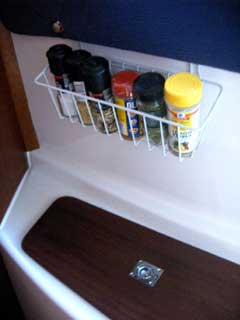
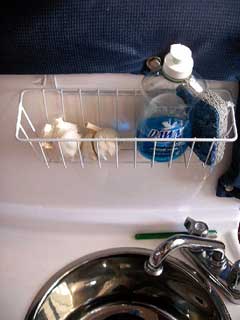 The above are just a few of the changes incorporated into the boat to make her reliable and comfortable for the upcoming trip. I’ve also purchased a Avon RIB Lite and 2 stroke Yamaha to be my car when I’m in an anchorage. This week I will stock up on those items that are hard to find in the islands, revue the final bills and accounting with my accountant, go to a couple of parties, then take off! I’m ready! The above are just a few of the changes incorporated into the boat to make her reliable and comfortable for the upcoming trip. I’ve also purchased a Avon RIB Lite and 2 stroke Yamaha to be my car when I’m in an anchorage. This week I will stock up on those items that are hard to find in the islands, revue the final bills and accounting with my accountant, go to a couple of parties, then take off! I’m ready!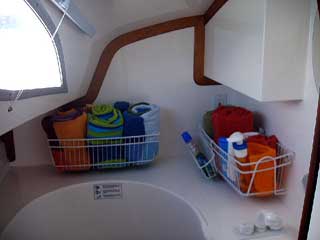
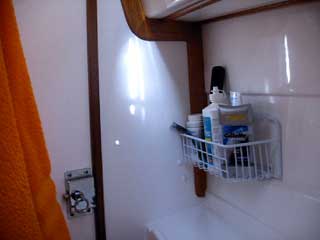 A special note of thanks to Kris and the crew at Bond Yachts, the makers of the Motorcat 30. Just before my departure I noticed that the hinges for the foredeck were bent. I emailed Motorcat and sent pictures of the hinges. There response was immediate! Not only did I get emails but even a phone call because some server or router on the internet was telling them that the emails weren’t getting to me. Kris explained that the hinges that I have were the original off the shelf hinges used early on in the production of the Motorcat and that subsequently they have been replaced with a much heavier hinge of a better design. I asked if there was anyway to get the hinges to my roommate well before my crossing over to the Bahamas, so that she would have time to send them to me and I would have time to install them. Kris said that he would try but that the hinges were coming from Poland so??? To my amazement, a few days after that email, Susan received a notice from the post office that a package was here for me. Fantastic customer service if you ask me, especially considering the fact that the boat is not under any warranty and the manufacturer is in Poland. So Kudos to Bond Yachts and thanks for the spectacular customer service! A special note of thanks to Kris and the crew at Bond Yachts, the makers of the Motorcat 30. Just before my departure I noticed that the hinges for the foredeck were bent. I emailed Motorcat and sent pictures of the hinges. There response was immediate! Not only did I get emails but even a phone call because some server or router on the internet was telling them that the emails weren’t getting to me. Kris explained that the hinges that I have were the original off the shelf hinges used early on in the production of the Motorcat and that subsequently they have been replaced with a much heavier hinge of a better design. I asked if there was anyway to get the hinges to my roommate well before my crossing over to the Bahamas, so that she would have time to send them to me and I would have time to install them. Kris said that he would try but that the hinges were coming from Poland so??? To my amazement, a few days after that email, Susan received a notice from the post office that a package was here for me. Fantastic customer service if you ask me, especially considering the fact that the boat is not under any warranty and the manufacturer is in Poland. So Kudos to Bond Yachts and thanks for the spectacular customer service!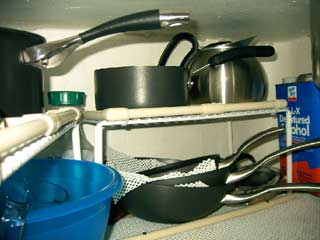
Evaluation after a month and a half of living aboard and cruising.
Posted 12/01/06
Now that I’ve had a bit of time on the boat, I figured that it was time to update and evaluate the boat and installed systems. Overall, I’m VERY happy with both and in fact have found the MC30 to be a very comfortable home with more than adequate room and storage for long term cruising. I must admit that this comes as a bit of a surprise to me as I really thought that, going to this sized vessel after cruising on a 36′ Europa style trawler, was going to wear on me a bit. It hasn’t. The boat is very well laid out and with the least bit of compromise, 2 people can live in comfort and harmony. Beyond that; the added speed, maneuverability and shallow draft have added a very positive dimension to this cruise that I really like. The weather, since I took off, has been way worse than in past years yet it hasn’t slowed me down or made me see less. The opposite is true if anything. I’ve seen and done more and have had the luxury of picking my weather and spending more time in the areas that I want. All this and using a little over half the amount of fuel/mile that I burned in my last Europa style trawler.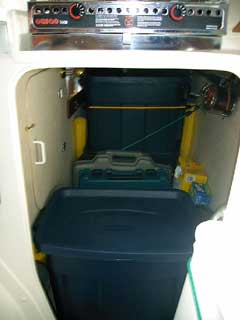
Ok, specifics on the engines, props and fuel. The boat has 2 50-hp 4-stroke Suzuki’s, using Amsoil synthetic marine 15w40 in the top and Amsoil synthetic marine gear lube in the lower, turning 12 x 9 Michigan Wheel, 4 blade, aluminum props. Since I’ve exceeded the designed weight limit of the boat, I figured that the four blade props would give me a little more “torque” to push that extra weight. My fuel usage has been surprisingly low considering that I almost always run the boat at a cruising R.P.M. of 4800-4900 which translates to a speed of about 15 to 17 mph depending on the sea state (remember, I’m overloaded and cats are VERY sensitive to weight beyond their design capacity).
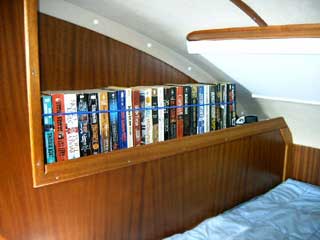 In my opinion the excess weight hasn’t really affected the handling of the boat and I’ve had her out in all kinds of rough seas since that’s all we’ve really had since I crossed over to the Bahamas. She’s slower out of the hole than before I loaded her down, but there are no issues that are of a safety nature as far as I’ve been able to determine (due to all the lawyers… let me add that I’m not a marine engineer, don’t try this at home, if you sink because you loaded the family car onto the bow don’t think of calling me to complain and the opinions contained in this page are just that, opinions!). My total (both engines total, not each individual engine!) hourly fuel usage has varied on this trip from a low of 2.8gph to a high of 4.5gph. Pretty darn economical if you ask me. In my opinion the excess weight hasn’t really affected the handling of the boat and I’ve had her out in all kinds of rough seas since that’s all we’ve really had since I crossed over to the Bahamas. She’s slower out of the hole than before I loaded her down, but there are no issues that are of a safety nature as far as I’ve been able to determine (due to all the lawyers… let me add that I’m not a marine engineer, don’t try this at home, if you sink because you loaded the family car onto the bow don’t think of calling me to complain and the opinions contained in this page are just that, opinions!). My total (both engines total, not each individual engine!) hourly fuel usage has varied on this trip from a low of 2.8gph to a high of 4.5gph. Pretty darn economical if you ask me.
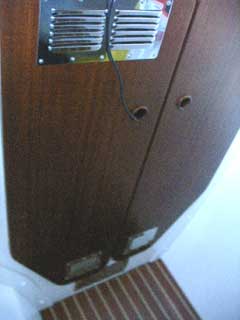 I did lie earlier in this page when I said that I would not be traveling with all of the water tanks filled. I really don’t notice any difference between having just the factory tank filled and all of the tanks (75gal) filled. The tanks are properly located somewhat centered in the boat and the boat trim, other than pushing the boat straight down a fraction of an inch, remains unaffected. And by having all of the tanks filled, it allows me way more freedom to hang out in those wonderful remote spots. I did lie earlier in this page when I said that I would not be traveling with all of the water tanks filled. I really don’t notice any difference between having just the factory tank filled and all of the tanks (75gal) filled. The tanks are properly located somewhat centered in the boat and the boat trim, other than pushing the boat straight down a fraction of an inch, remains unaffected. And by having all of the tanks filled, it allows me way more freedom to hang out in those wonderful remote spots.
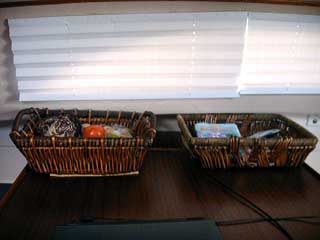 The down side of this boat are so minor as to be hardly worth mentioning but, to be complete, I will. There are only 2 things that I can think of, and they are by no means unique to this boat. The first is that in higher winds (20 – 40kts), when anchored, the boat wants to sail back and forth a bit. I’ve tried a bridle with some success and am testing a new variation. If it works, I’ll post the design here. The second thing is something that afflicts all fiberglass boats but white ones the most. The static electrical properties of both the fiberglass and hair means that there’s always hair stuck to the fiberglass inside the boat. No huge deal, but you really need something sticky like a Swiffer TM or vacuum cleaner to remove them. Just using a cleaning spray and paper towel doesn’t work well. That’s it… not bad at all! The down side of this boat are so minor as to be hardly worth mentioning but, to be complete, I will. There are only 2 things that I can think of, and they are by no means unique to this boat. The first is that in higher winds (20 – 40kts), when anchored, the boat wants to sail back and forth a bit. I’ve tried a bridle with some success and am testing a new variation. If it works, I’ll post the design here. The second thing is something that afflicts all fiberglass boats but white ones the most. The static electrical properties of both the fiberglass and hair means that there’s always hair stuck to the fiberglass inside the boat. No huge deal, but you really need something sticky like a Swiffer TM or vacuum cleaner to remove them. Just using a cleaning spray and paper towel doesn’t work well. That’s it… not bad at all!
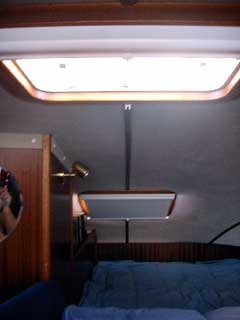 A quick note on my favorite anchor, the Spade 15lb aluminum. Great anchor. So far, it’s only not set with my first try, two times. Both were in thick grass and both times I got it to bury on the second attempt. I forgot to put in a swivel between the anchor and the chain and am looking to get one at my next opportunity. A quick note on my favorite anchor, the Spade 15lb aluminum. Great anchor. So far, it’s only not set with my first try, two times. Both were in thick grass and both times I got it to bury on the second attempt. I forgot to put in a swivel between the anchor and the chain and am looking to get one at my next opportunity.
The rest of the evaluation will be attached to the pictures. Click on the picture of interest and a larger version will pop up along with my comments.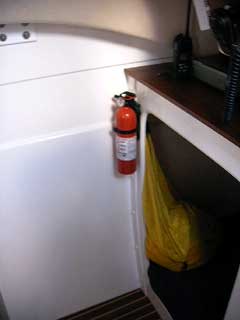
|
 Finally, after 6 months of working on the boat, the time is here to leave on the cruise. As all of my friends know; every few years I buy a new (to me) boat, outfit her for extended cruising and then take off for a winter of cruising and spear fishing in the Bahamas. When I get back, I sell the boat and go back to work. Friends have often asked me why I sell my boats when I get back, why not just keep one of them? After all, I had spent months on upgrading all of the systems; invested hundreds of hours and thousands of dollar to just then turn around and sell them. The answer is that boats don’t do well if they’re not being used on a regular basis. My job has me traveling all over the country with no time at home to use the boat. To be worrying about my boat during winter freezes or hurricane season also takes away from my focus on work. To this end, every few years when I get back from a cruise, someone gets to buy a boat that has been gone over with a fine tooth comb and has been meticulously upgraded with only the finest quality marine components.
Finally, after 6 months of working on the boat, the time is here to leave on the cruise. As all of my friends know; every few years I buy a new (to me) boat, outfit her for extended cruising and then take off for a winter of cruising and spear fishing in the Bahamas. When I get back, I sell the boat and go back to work. Friends have often asked me why I sell my boats when I get back, why not just keep one of them? After all, I had spent months on upgrading all of the systems; invested hundreds of hours and thousands of dollar to just then turn around and sell them. The answer is that boats don’t do well if they’re not being used on a regular basis. My job has me traveling all over the country with no time at home to use the boat. To be worrying about my boat during winter freezes or hurricane season also takes away from my focus on work. To this end, every few years when I get back from a cruise, someone gets to buy a boat that has been gone over with a fine tooth comb and has been meticulously upgraded with only the finest quality marine components. In the past, I’ve taken sailboats, such as; Pacific Seacrafts, Island Packets, a Gemini 105Mc and even a Marine Trader Europa trawler on this cruise. This year I bought a Motorcat 30 for my trip because I was looking for a faster, shallow draft, motor vessel that could be trailered during the hurricane season and would be able to take the best advantage of the winter weather patterns common to the southern Bahamas. A boat that could take advantage of the one day of oily slick, 200 foot visibility (surrounded by lots of days with somewhat choppy water with visibility ranging from 20′ to 100′) and make a day trip diving run from the Exumas to the Jumentos or Conception Island or even Rum Cay. I wanted a boat that would be reasonably economical to operate and have the creature comforts needed for 8 months of living aboard. The only boat that I could find that fit all of my requirements with the least amount of compromise was the Motorcat 30, made by Bond Yachts. So early this spring, I bought the only used Motorcat on the market, a 2002 model, and and started to work on her to bring her up to my specifications for extended cruising and diving in the Bahamas.
In the past, I’ve taken sailboats, such as; Pacific Seacrafts, Island Packets, a Gemini 105Mc and even a Marine Trader Europa trawler on this cruise. This year I bought a Motorcat 30 for my trip because I was looking for a faster, shallow draft, motor vessel that could be trailered during the hurricane season and would be able to take the best advantage of the winter weather patterns common to the southern Bahamas. A boat that could take advantage of the one day of oily slick, 200 foot visibility (surrounded by lots of days with somewhat choppy water with visibility ranging from 20′ to 100′) and make a day trip diving run from the Exumas to the Jumentos or Conception Island or even Rum Cay. I wanted a boat that would be reasonably economical to operate and have the creature comforts needed for 8 months of living aboard. The only boat that I could find that fit all of my requirements with the least amount of compromise was the Motorcat 30, made by Bond Yachts. So early this spring, I bought the only used Motorcat on the market, a 2002 model, and and started to work on her to bring her up to my specifications for extended cruising and diving in the Bahamas. 
 Before I decided what to install on the boat, I went through the boat in great lengths with a flashlight, multimeter and other tools required to remove trim panels etc. and see how she was made. My first impression (one that I still have today) is that the fiberglass work done on this boat is some of the best that I’ve ever seen. I have yet to find a void or unbonded glass/coring. On the other hand, I wasn’t thrilled with the use of stainless washers for backing plates. So my first job was installing aluminum backing plates everywhere. Anywhere there was coring, I drilled out the bolt holes oversized, filled in the holes with thickened epoxy and then redrilled the holes to the proper bolt size through the cured epoxy before bolting back the fitting with it’s new aluminum backing plate. I’ve recently been told, by a marine surveyor, that this is overkill on my part, but it makes me feel better so… In some cases, plywood or starboard were used as backing plates because the material was more appropriate for the particular application.
Before I decided what to install on the boat, I went through the boat in great lengths with a flashlight, multimeter and other tools required to remove trim panels etc. and see how she was made. My first impression (one that I still have today) is that the fiberglass work done on this boat is some of the best that I’ve ever seen. I have yet to find a void or unbonded glass/coring. On the other hand, I wasn’t thrilled with the use of stainless washers for backing plates. So my first job was installing aluminum backing plates everywhere. Anywhere there was coring, I drilled out the bolt holes oversized, filled in the holes with thickened epoxy and then redrilled the holes to the proper bolt size through the cured epoxy before bolting back the fitting with it’s new aluminum backing plate. I’ve recently been told, by a marine surveyor, that this is overkill on my part, but it makes me feel better so… In some cases, plywood or starboard were used as backing plates because the material was more appropriate for the particular application. 
 I went through the electrical system and found several problems. The factory did a nice job with the wiring, but subsequent owners or yards had made changes that ranged from inappropriate to dangerous. Dangerous was the 10′ piece of Romex wire used to hook up the microwave which I subsequently removed because it blocked access to much of the limited amount of galley storage. Inappropriate was the 3-way electrical switch that was wired into the system before the factory installed engine on/off switch and the house bank on/off switch in an attempt to have a way to combine the batteries if the starting battery was low. What that did was negate the factory installed on off switches that kept the banks separate. With the way it was set up, you could either run both house and engines off of battery bank one, two or have them combined but you could not run the engines off of the engine battery while at the same time running the house load off of the house bank. I rewired the batteries back to the way the factory had them and then wired in the 3 way switch strictly as an on/off switch to combine the 2 banks. I put in 4 new 6 volt golf cart batteries for the house bank and wired in a Blue Sky Solar Boost 2000e regulator for the two 130 watt solar panels that I’ll get from e-Marine in Ft. Lauderdale. All the wiring has been done, as has the stainless mounting rods so the panels shouldn’t take but a few minutes to mount and hook up. The reason for waiting till Ft. Lauderdale (besides not needing the power as I’m motoring from marina to marina as I head down the coast) is that I’ve dealt with
I went through the electrical system and found several problems. The factory did a nice job with the wiring, but subsequent owners or yards had made changes that ranged from inappropriate to dangerous. Dangerous was the 10′ piece of Romex wire used to hook up the microwave which I subsequently removed because it blocked access to much of the limited amount of galley storage. Inappropriate was the 3-way electrical switch that was wired into the system before the factory installed engine on/off switch and the house bank on/off switch in an attempt to have a way to combine the batteries if the starting battery was low. What that did was negate the factory installed on off switches that kept the banks separate. With the way it was set up, you could either run both house and engines off of battery bank one, two or have them combined but you could not run the engines off of the engine battery while at the same time running the house load off of the house bank. I rewired the batteries back to the way the factory had them and then wired in the 3 way switch strictly as an on/off switch to combine the 2 banks. I put in 4 new 6 volt golf cart batteries for the house bank and wired in a Blue Sky Solar Boost 2000e regulator for the two 130 watt solar panels that I’ll get from e-Marine in Ft. Lauderdale. All the wiring has been done, as has the stainless mounting rods so the panels shouldn’t take but a few minutes to mount and hook up. The reason for waiting till Ft. Lauderdale (besides not needing the power as I’m motoring from marina to marina as I head down the coast) is that I’ve dealt with 
 Hope that I’m not boring anyone too badly yet… I installed a hatch in the head to replace the vent, window shades and Oceanair hatch shades. The head was replaced. Wire shelving and baskets were installed to organize the storage without adding significant weight. An Origo 3000 stove was installed, as well as, a Magma Newport (great grill, way better than the old Magna kettles!). A shower was added at the stern platform as well as 2 water tanks, one flexible and one custom made polyethylene, bringing the water capacity to ~75gals. One note on the water tankage – catamarans are very weight sensitive so the tanks were installed centrally to minimize their effect on performance. Also when traveling, I do not plan on carrying a full load of water, that’s only for the 90% of the time when I’m at anchor. I replaced all of the tank fills, as the ones from the factory are made in a way that facilitates water wicking off of the deck and into the tanks if the o-rings are at all compromised. I installed a, new to the market, Lewmar Profish 700 stainless steel freefall windlass. This is a beautiful windlass that makes so much sense. When you reach your destination, this windlass uses a minimum of power to put down the anchor in freefall mode, at a time that you are about to shut down your engines and want to use as little power as possible. The company (Lewmar) is fabulous! I had one minor issue, after installing this windlass, that I think could have been fixed with the application of a lubricant. When I questioned Lewmar about it, they said that “because I was leaving on a trip and was having issues with a new unit,” they would send out a new one immediately and for me to just return the one I had. Two days later, I had the new unit. It took little time to switch the two out, and I did notice that the new unit had the piece in question pre-lubricated. Amazing for a company to go to these lengths to ensure their customers happiness. Bravo Lewmar! And finally, I’ve gone through the 2 Suzuki DF50 4 stroke outboards changing all of the lube, the water pumps, fuel filters and plugs just to get a bit familiar with them. Oh… I almost forgot, I bought a new aluminum Float-On trailer, but that’s a story in itself…
Hope that I’m not boring anyone too badly yet… I installed a hatch in the head to replace the vent, window shades and Oceanair hatch shades. The head was replaced. Wire shelving and baskets were installed to organize the storage without adding significant weight. An Origo 3000 stove was installed, as well as, a Magma Newport (great grill, way better than the old Magna kettles!). A shower was added at the stern platform as well as 2 water tanks, one flexible and one custom made polyethylene, bringing the water capacity to ~75gals. One note on the water tankage – catamarans are very weight sensitive so the tanks were installed centrally to minimize their effect on performance. Also when traveling, I do not plan on carrying a full load of water, that’s only for the 90% of the time when I’m at anchor. I replaced all of the tank fills, as the ones from the factory are made in a way that facilitates water wicking off of the deck and into the tanks if the o-rings are at all compromised. I installed a, new to the market, Lewmar Profish 700 stainless steel freefall windlass. This is a beautiful windlass that makes so much sense. When you reach your destination, this windlass uses a minimum of power to put down the anchor in freefall mode, at a time that you are about to shut down your engines and want to use as little power as possible. The company (Lewmar) is fabulous! I had one minor issue, after installing this windlass, that I think could have been fixed with the application of a lubricant. When I questioned Lewmar about it, they said that “because I was leaving on a trip and was having issues with a new unit,” they would send out a new one immediately and for me to just return the one I had. Two days later, I had the new unit. It took little time to switch the two out, and I did notice that the new unit had the piece in question pre-lubricated. Amazing for a company to go to these lengths to ensure their customers happiness. Bravo Lewmar! And finally, I’ve gone through the 2 Suzuki DF50 4 stroke outboards changing all of the lube, the water pumps, fuel filters and plugs just to get a bit familiar with them. Oh… I almost forgot, I bought a new aluminum Float-On trailer, but that’s a story in itself… 
 The above are just a few of the changes incorporated into the boat to make her reliable and comfortable for the upcoming trip. I’ve also purchased a Avon RIB Lite and 2 stroke Yamaha to be my car when I’m in an anchorage. This week I will stock up on those items that are hard to find in the islands, revue the final bills and accounting with my accountant, go to a couple of parties, then take off! I’m ready!
The above are just a few of the changes incorporated into the boat to make her reliable and comfortable for the upcoming trip. I’ve also purchased a Avon RIB Lite and 2 stroke Yamaha to be my car when I’m in an anchorage. This week I will stock up on those items that are hard to find in the islands, revue the final bills and accounting with my accountant, go to a couple of parties, then take off! I’m ready!
 A special note of thanks to Kris and the crew at Bond Yachts, the makers of the Motorcat 30. Just before my departure I noticed that the hinges for the foredeck were bent. I emailed Motorcat and sent pictures of the hinges. There response was immediate! Not only did I get emails but even a phone call because some server or router on the internet was telling them that the emails weren’t getting to me. Kris explained that the hinges that I have were the original off the shelf hinges used early on in the production of the Motorcat and that subsequently they have been replaced with a much heavier hinge of a better design. I asked if there was anyway to get the hinges to my roommate well before my crossing over to the Bahamas, so that she would have time to send them to me and I would have time to install them. Kris said that he would try but that the hinges were coming from Poland so??? To my amazement, a few days after that email, Susan received a notice from the post office that a package was here for me. Fantastic customer service if you ask me, especially considering the fact that the boat is not under any warranty and the manufacturer is in Poland. So Kudos to Bond Yachts and thanks for the spectacular customer service!
A special note of thanks to Kris and the crew at Bond Yachts, the makers of the Motorcat 30. Just before my departure I noticed that the hinges for the foredeck were bent. I emailed Motorcat and sent pictures of the hinges. There response was immediate! Not only did I get emails but even a phone call because some server or router on the internet was telling them that the emails weren’t getting to me. Kris explained that the hinges that I have were the original off the shelf hinges used early on in the production of the Motorcat and that subsequently they have been replaced with a much heavier hinge of a better design. I asked if there was anyway to get the hinges to my roommate well before my crossing over to the Bahamas, so that she would have time to send them to me and I would have time to install them. Kris said that he would try but that the hinges were coming from Poland so??? To my amazement, a few days after that email, Susan received a notice from the post office that a package was here for me. Fantastic customer service if you ask me, especially considering the fact that the boat is not under any warranty and the manufacturer is in Poland. So Kudos to Bond Yachts and thanks for the spectacular customer service!

 In my opinion the excess weight hasn’t really affected the handling of the boat and I’ve had her out in all kinds of rough seas since that’s all we’ve really had since I crossed over to the Bahamas. She’s slower out of the hole than before I loaded her down, but there are no issues that are of a safety nature as far as I’ve been able to determine (due to all the lawyers… let me add that I’m not a marine engineer, don’t try this at home, if you sink because you loaded the family car onto the bow don’t think of calling me to complain and the opinions contained in this page are just that, opinions!). My total (both engines total, not each individual engine!) hourly fuel usage has varied on this trip from a low of 2.8gph to a high of 4.5gph. Pretty darn economical if you ask me.
In my opinion the excess weight hasn’t really affected the handling of the boat and I’ve had her out in all kinds of rough seas since that’s all we’ve really had since I crossed over to the Bahamas. She’s slower out of the hole than before I loaded her down, but there are no issues that are of a safety nature as far as I’ve been able to determine (due to all the lawyers… let me add that I’m not a marine engineer, don’t try this at home, if you sink because you loaded the family car onto the bow don’t think of calling me to complain and the opinions contained in this page are just that, opinions!). My total (both engines total, not each individual engine!) hourly fuel usage has varied on this trip from a low of 2.8gph to a high of 4.5gph. Pretty darn economical if you ask me. I did lie earlier in this page when I said that I would not be traveling with all of the water tanks filled. I really don’t notice any difference between having just the factory tank filled and all of the tanks (75gal) filled. The tanks are properly located somewhat centered in the boat and the boat trim, other than pushing the boat straight down a fraction of an inch, remains unaffected. And by having all of the tanks filled, it allows me way more freedom to hang out in those wonderful remote spots.
I did lie earlier in this page when I said that I would not be traveling with all of the water tanks filled. I really don’t notice any difference between having just the factory tank filled and all of the tanks (75gal) filled. The tanks are properly located somewhat centered in the boat and the boat trim, other than pushing the boat straight down a fraction of an inch, remains unaffected. And by having all of the tanks filled, it allows me way more freedom to hang out in those wonderful remote spots. The down side of this boat are so minor as to be hardly worth mentioning but, to be complete, I will. There are only 2 things that I can think of, and they are by no means unique to this boat. The first is that in higher winds (20 – 40kts), when anchored, the boat wants to sail back and forth a bit. I’ve tried a bridle with some success and am testing a new variation. If it works, I’ll post the design here. The second thing is something that afflicts all fiberglass boats but white ones the most. The static electrical properties of both the fiberglass and hair means that there’s always hair stuck to the fiberglass inside the boat. No huge deal, but you really need something sticky like a Swiffer TM or vacuum cleaner to remove them. Just using a cleaning spray and paper towel doesn’t work well. That’s it… not bad at all!
The down side of this boat are so minor as to be hardly worth mentioning but, to be complete, I will. There are only 2 things that I can think of, and they are by no means unique to this boat. The first is that in higher winds (20 – 40kts), when anchored, the boat wants to sail back and forth a bit. I’ve tried a bridle with some success and am testing a new variation. If it works, I’ll post the design here. The second thing is something that afflicts all fiberglass boats but white ones the most. The static electrical properties of both the fiberglass and hair means that there’s always hair stuck to the fiberglass inside the boat. No huge deal, but you really need something sticky like a Swiffer TM or vacuum cleaner to remove them. Just using a cleaning spray and paper towel doesn’t work well. That’s it… not bad at all! A quick note on my favorite anchor, the Spade 15lb aluminum. Great anchor. So far, it’s only not set with my first try, two times. Both were in thick grass and both times I got it to bury on the second attempt. I forgot to put in a swivel between the anchor and the chain and am looking to get one at my next opportunity.
A quick note on my favorite anchor, the Spade 15lb aluminum. Great anchor. So far, it’s only not set with my first try, two times. Both were in thick grass and both times I got it to bury on the second attempt. I forgot to put in a swivel between the anchor and the chain and am looking to get one at my next opportunity.